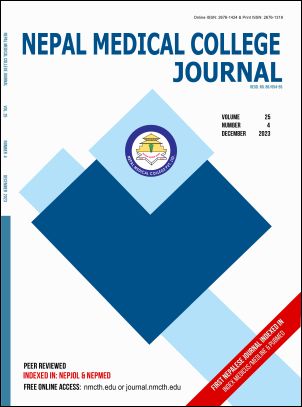Study of effectiveness of two syringe spinal anaesthesia technique for caesarean section
DOI:
https://doi.org/10.3126/nmcj.v25i4.60875Keywords:
Spinal anaesthesia, bupivacaine, seperate syringe, caesarean section, fentanylAbstract
Spinal anaesthesia using hyperbaric bupivacaine is the most popular method for caesarean section. Adjuvents like fentanyl which enhances the sensory block and provide stable haemodynamics are usually premixed with bupivacaine in a single syringe. Fentanyl when added to hyperbaric bupivacaine, decreases the density of solution to extent of 0.0006 which alters the spread of local anesthetics in CSF. If we inject both the drugs separately in different syringe, it may minimize the effect of the changes in densities and PH of both the drugs and produce their maximum effect with minimal haemodynamic alteration. Therefore this study was conducted to see the quality of sensory block and haemodynamic response by sequential intrathecal administration of fentanyl and hyperbaric bupivacaine in two different syringe for patients undergoing caesarian section. This interventional study was carried out in Seventy nine Patients undergoing caesarean section under spinal anesthesia with 0.5% hyperbaric bupivacaine 9mg (1.8 ml) and fentanyl 20 mcg in two different syringe administered sequentially. Out of 79 parturients only 22 (27.85%) had hypotension requiring vasopressor treatment during caesarean section and maximum amount of vasopressor used was 15 mg of mephentermine. The mean level of maximum sensory block after 20 mins of spinal anaesthesia was T2 in 20 (25.32%) patients, T3 in 19 (24.05%) patients, T4 in 32 (40.51%) patients, T5 in 1 (1.27%) patient and T6 in 7 (8.86%) Patients. Intraoperative quality of surgical anaesthesia was very satisfactory to the patients. Only 6 (7.59%) patients had mild discomfort whithout requirement of any medical treatment. The result of this study concluded that separate intrathecal injection of fentanyl and hyperbaric bupivacaine provides better haemodynamic stability, improves quality of surgical anaethesia allowing it to work at higher levels in the spinal cord with minimal other side effects in patient undergoing caesarean section.
Downloads
Downloads
Published
How to Cite
Issue
Section
License
Copyright (c) 2023 Nepal Medical College Journal

This work is licensed under a Creative Commons Attribution 4.0 International License.
This license enables reusers to distribute, remix, adapt, and build upon the material in any medium or format, so long as attribution is given to the creator. The license allows for commercial use.




